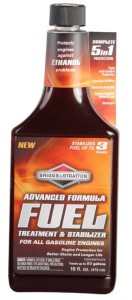Ethanol in gas
Can I run my lawn mower with ethanol in gas
Ethanol in gas can pose problems if you don’t handle it correctly. Ethanol is added to gas so it can meet EPA standards for oxygenated gas to reduce CO emissions. The old oxygenate additive MTBE was found to be carcinogenic and, when it leaked from underground tanks, would pollute the water table. So gasoline suppliers switched to ethanol.
Why is ethanol in gas?
Ethanol adds more oxygen to the combustion process and it increases the octane level of the gasoline slightly. But it has some distinct disadvantages—it doesn’t store well. Ethanol separates out of the gas the instant it comes in contact with water or moisture. This is called phase separation. So any humidity in the air in the storage container or gas tank will be absorbed by the ethanol. That water clings to the ethanol and both fall to the bottom of the tank (it’s heavier than gas) where it can cause damage to the metal tank. In addition to corroding a metal tank, that water/ethanol blend will be the first “gas” to be sucked into the carburetor when you try to start the engine, causing starting problems and carburetor corrosion.
Ethanol in gas requires fuel stabilizer
That’s why it’s so important to use a fuel stabilizer for gas that’s going to be used in small engines. First, fuel stabilizer slows down the phase separation process. Secondly, some fuel stabilizers have anti-corrosive and metal deactivation additives to prevent water in the gas from corroding metal parts in the small engine carburetor.
People think they can add fuel stabilizer to the ethanol in gas to bring it back to life. WRONG. Once the phase separation has occurred, it’s done. That gas can’t be brought back to life. The correct way to add fuel stabilizer is AT the gas pump  when you’re filling the container with fresh gas. That gives the stabilizer a chance to mix with the ethanol in gas so it can do its job.
when you’re filling the container with fresh gas. That gives the stabilizer a chance to mix with the ethanol in gas so it can do its job.
How to store a small engine
Everyone asks about the proper way to store a small engine when it’s out of season. Well, there’s no simple answer. Some small engine manufacturers recommend running the engine complete dry (with stabilizer fuel added first). That way, the fuel remaining in the tank will be stabilized. Other engine manufacturers want you to fill the tank to the brim with stabilized fuel. That way, the tank won’t accumulate much water.
In addition to following the manufacturer’s recommendations for gas, you should also change the oil. Fresh oil contains anti-corrosive additives that are critical to preventing corrosion during storage. Don’t leave old oil in the crankcase over winter or summer storage periods.
©, 2015 Rick Muscoplat
Posted on by Rick Muscoplat